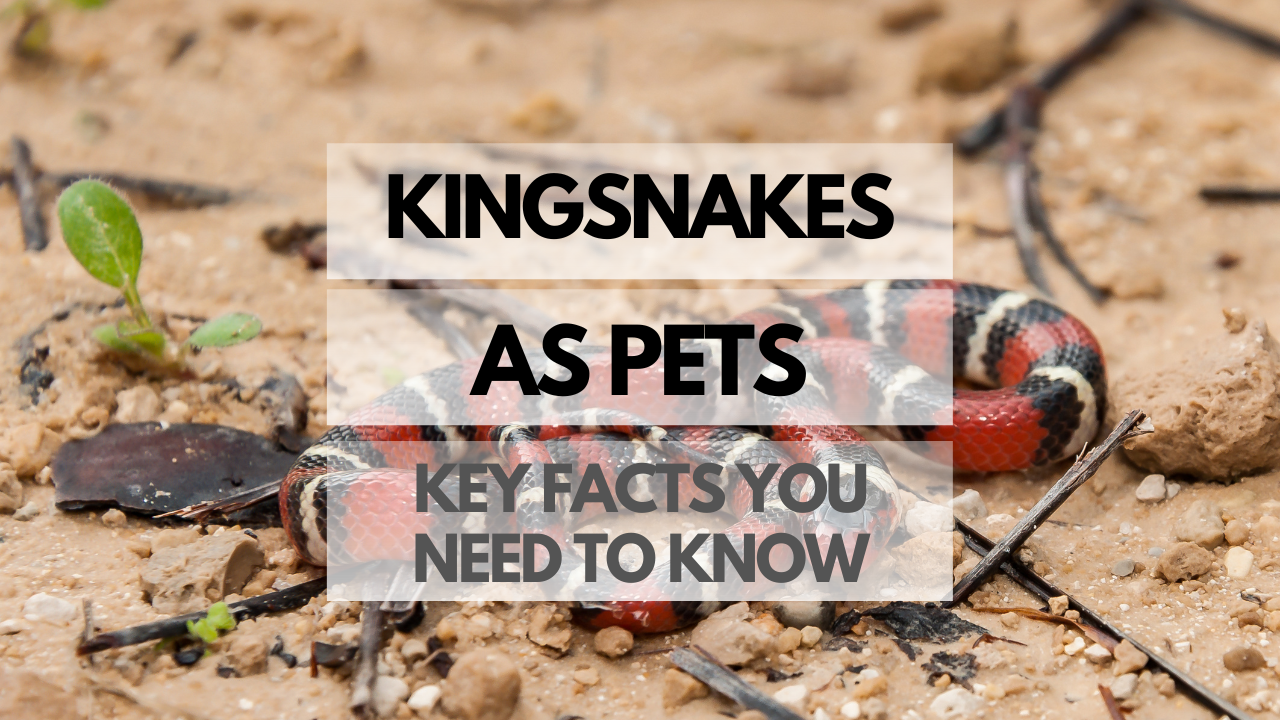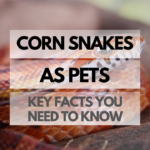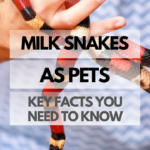If you’re considering a pet snake, the Kingsnake is a popular choice for many reasons. These fascinating reptiles have a long history in the pet trade and are known for their striking appearance, docile temperament, and relatively low maintenance requirements. In this article, we’ll dive into everything you need to know about keeping a Kingsnake as a pet.
Quick Reference Table: Kingsnake Facts
| Fact | Detail |
|---|---|
| Size | 3-6 feet (depending on species) |
| Lifespan | 15-20 years |
| Diet | Carnivorous (primarily rodents) |
| Temperament | Docile and easy to handle |
| Cost | $50-$300 (depending on species and coloration) |
| Enclosure Size | 20-40 gallons (depending on snake size) |
| Temperature | 75-85°F (with a basking area of 88-90°F) |
| Humidity | 40-60% |
How Are Kingsnakes as Pets?
Kingsnakes make excellent pets for both beginners and experienced reptile enthusiasts. They are known for their docile nature, low maintenance requirements, and adaptability to various environments. Moreover, their wide variety of colors and patterns can make them a visually striking addition to any home.
Pros and Cons of Kingsnakes
Pros:
- Docile and easy to handle
- Low maintenance requirements
- Long lifespan
- Wide variety of colors and patterns
Cons:
- Require a consistent feeding schedule
- Need a properly maintained enclosure
- May become stressed if over-handled
Kingsnake Behavior and Temperament
Kingsnakes are generally docile and easy to handle, making them a great choice for those new to reptile care. They are typically not aggressive and can become comfortable with regular, gentle handling. However, it’s essential to give them space and time to adjust to their new environment and avoid over-handling, which can cause stress.
How Much Do Kingsnakes Cost?
The initial cost of a Kingsnake can range from $50 to $300, depending on the species and coloration. In addition to the snake itself, you’ll need to invest in a proper enclosure, heating and lighting equipment, substrate, and decor. Ongoing expenses include food, occasional veterinary care, and replacement of supplies as needed.
Kingsnake Lifespan: Time and Commitment
Kingsnakes have a life expectancy of 15-20 years in captivity, making them a long-term commitment for any pet owner. It’s important to consider the time and dedication required to properly care for a Kingsnake, including maintaining their habitat, providing a consistent feeding schedule, and ensuring they receive appropriate veterinary care.
Kingsnake Size
Depending on the species, adult Kingsnakes can range in size from 3 to 6 feet in length. This moderate size makes them manageable for most pet owners and allows them to be housed in enclosures that are more easily accommodated in a home setting.
Kingsnake Species
There are several species of Kingsnakes, each with their unique appearance and characteristics. Some of the most popular species include:
California Kingsnake (Lampropeltis californiae)
Known for their striking black and white banding, California Kingsnakes are a popular choice among pet owners. They typically grow to around 3-4 feet in lengthand are native to the southwestern United States and northern Mexico.
Eastern Kingsnake (Lampropeltis getula)
Eastern Kingsnakes feature a black or dark brown base color with a chain-like pattern of white or yellow bands. They are found in the eastern United States and can grow up to 4-6 feet in length.
Mexican Black Kingsnake (Lampropeltis getula nigrita)
These all-black snakes are highly sought after for their stunning appearance. Mexican Black Kingsnakes are native to northern Mexico and the southwestern United States, and they typically grow to around 3-4 feet in length.
Kingsnake Colors, Looks, and Appearances
Kingsnakes are known for their beautiful colors and patterns, which can vary widely depending on the species. Some common color variations include banded, striped, or speckled patterns in combinations of black, white, red, yellow, and brown. Their unique appearance makes them a visually appealing choice for a pet snake.
Kingsnake Care Guide
Proper care is essential to ensure your Kingsnake thrives in captivity. In this section, we’ll cover the basics of Kingsnake care, including habitat setup, feeding, and general maintenance.
Kingsnake Habitat: Tank and Housing
Creating a comfortable and secure environment for your Kingsnake is crucial to their health and well-being. This includes choosing an appropriate enclosure, providing the right substrate, and maintaining proper heating, lighting, and humidity levels.
Appropriate Kingsnake Tank Size
A 20-40 gallon tank is generally sufficient for most Kingsnakes, depending on their size. Ensure the enclosure has a secure lid to prevent escape and plenty of floor space for your snake to explore and hide.
Types of Enclosures
While glass aquariums are the most common choice for snake enclosures, PVC or plastic enclosures can also be used. These options tend to retain heat and humidity better than glass, making them a suitable choice for Kingsnakes.
Substrate Options
Aspen shavings, cypress mulch, or coconut husk are suitable substrate options for your Kingsnake’s enclosure. These materials help maintain humidity levels and provide a comfortable surface for your snake to move on. Avoid using sand, pine, or cedar shavings, as they can cause respiratory issues.
Heating and Lighting Requirements
Kingsnakes require a temperature gradient in their enclosure, with a cooler area of around 75-80°F and a basking area of 88-90°F. Under-tank heating pads or heat tape can be used to achieve this gradient. Supplemental lighting is not required, but a low-wattage basking bulb or ceramic heat emitter can be used to provide additional warmth if needed.
Humidity and Temperature Control
Maintaining a humidity level of 40-60% is essential for your Kingsnake’s health. A hygrometer can help monitor humidity levels, and misting the enclosure or providing a humid hide can help maintain proper conditions. A digital thermometer or temperature gun can be used to ensure the enclosure stays within the appropriate temperature range.
Furnishings and Decorations
Provide your Kingsnake with various hiding spots and climbing opportunities, such as branches, cork bark, or PVC tubes. These items can help your snake feel secure and provide enrichment within their environment.
Cleaning and Maintenance
Spot clean your Kingsnake’s enclosure daily by removing any waste or soiled substrate. Perform a complete enclosure cleaning and substrate replacement every 4-6 weeks to maintain a clean and healthy environment for your snake.
Kingsnake Food: Diet and Nutrition
Kingsnakes are carnivorous and primarily eat rodents in captivity. It’s important to provide a balanced diet and proper feeding schedule to ensure their health and well-being.
Feeding Frequency and Schedule
Young Kingsnakes should be fed every 5-7 days, while adults can be fed every 10-14 days. Adjust the feeding schedule as needed to maintain a healthy body weight for your snake.
What do Kingsnakes Eat?
Kingsnakes primarily eat rodents, such as mice or small rats, in captivity. Pre-killed, frozen-thawed rodents are the safest and most convenient option for feeding your snake.
Kingsnake Treats
While Kingsnakes primarily eat rodents like mice and rats, they may also enjoy a variety of treats. These can include feeder insects like crickets or mealworms, small fish, and even small birds like quails. Make sure to offer treats only occasionally and in moderation, as they should not replace the main diet of rodents.
Foods to Avoid
There are several foods that you should avoid feeding your Kingsnake. Some examples include insects caught from the wild (due to potential pesticide exposure), fruits and vegetables (as they are not part of their natural diet), and live prey (due to the risk of injury to your snake).
Supplements and Vitamins
Kingsnakes typically receive all the necessary nutrients from their diet of rodents. However, occasionally dusting prey items with a calcium supplement can help ensure they receive adequate calcium for healthy bone growth and development.
Hydration
While Kingsnakes get most of their hydration from their prey, it’s still essential to provide a water dish in their enclosure. Make sure the dish is large enough for your snake to soak in but shallow enough to prevent drowning. Change the water regularly and clean the dish to maintain hygiene.
Handling and Socialization
Taming and Bonding
With regular handling and gentle interactions, most Kingsnakes can become quite tame and easy to handle. Begin by handling your snake for short periods of time, gradually increasing the duration as they become more comfortable. Be patient, and always handle your snake with care.
Safe Handling Techniques
When handling your Kingsnake, use both hands to support their body, avoiding sudden movements that may startle them. Avoid handling them immediately after feeding, as this can cause regurgitation. Be mindful of your snake’s body language and return them to their enclosure if they show signs of stress or discomfort.
Signs of Stress and Illness
Signs of stress in Kingsnakes can include excessive hiding, hissing, striking, or attempting to escape. Monitor your snake closely for signs of illness, such as lethargy, loss of appetite, skin discoloration, or difficulty breathing. If you notice any concerning symptoms, consult a reptile veterinarian as soon as possible.
Introducing Kingsnakes to Other Pets
Kingsnakes are best housed individually, as they can be cannibalistic. Introducing them to other pets, particularly other snakes, may result in aggression or injury. If you have other pets, ensure they are kept in separate enclosures to avoid any potential issues.
Health and Wellness
Common Health Issues
Some common health issues that may affect Kingsnakes include respiratory infections, mites, parasites, and shedding difficulties. Maintain a clean and properly set-up enclosure to minimize the risk of these issues and consult a reptile veterinarian if you suspect your snake is unwell.
Signs of a Healthy Kingsnake
A healthy Kingsnake will have clear eyes, smooth skin, a strong appetite, and regular elimination habits. They should be active and alert when handled, with no signs of lethargy or distress.
Preventative Care
Regular cleaning of the enclosure, proper temperature and humidity levels, and a balanced diet are crucial for keeping your Kingsnake healthy. Monitor your snake for any signs of illness and establish a relationship with a reptile veterinarian for routine check-ups and care.
Finding a Reptile Veterinarian
Look for a veterinarian with experience in treating reptiles, particularly snakes. You can search online for local reptile veterinarians, ask for recommendations from fellow reptile owners, or consult with a local herpetological society for guidance.
Breeding and Reproduction
Determining Gender
Determining the gender of yourKingsnake can be challenging, but a trained reptile veterinarian or experienced breeder can help. Males typically have longer and thicker tails than females, and the presence of hemipenes (male reproductive organs) can be detected through a process called probing.
Mating Behavior and Courtship
Kingsnakes breed in the spring after emerging from brumation (a period of reduced activity during winter months). Males will search for females and engage in courtship behaviors, such as rubbing their bodies against the female and wrapping their tails around her. If receptive, the female will allow the male to copulate.
Gravidity and Egg-laying
Females become gravid (pregnant) after mating and will lay a clutch of eggs, typically ranging from 5 to 20 eggs, several weeks later. Provide a suitable nesting box filled with moist substrate, such as sphagnum moss or vermiculite, to encourage egg-laying.
Incubation and Hatching
Kingsnake eggs require a consistent temperature of around 82°F (28°C) and high humidity to incubate successfully. Incubation usually takes between 50 and 65 days. Once the eggs begin to hatch, the baby snakes will emerge and start exploring their environment.
Caring for Hatchlings
Hatchling Kingsnakes should be housed separately in smaller enclosures to prevent cannibalism. They will typically shed their skin for the first time within a week of hatching and should begin feeding on appropriately-sized pinky mice soon after.
Are Kingsnakes Legal?
Kingsnakes are legal to own as pets in most areas. However, regulations can vary depending on your location, so it’s essential to check your local laws and obtain any necessary permits before acquiring a Kingsnake.
Popular Names for Kingsnakes
Looking for the perfect name for your new scaly friend? Here’s a list of fun and interesting names to consider:
- Slinky
- Bandit
- Royal
- Medusa
- King Arthur
- Twix
- Checkers
- Jester
- Ziggy
- Merlin
Conclusion: Should You Own Kingsnakes as Pets?
Before deciding to bring a Kingsnake into your home, it’s crucial to consider whether you can provide the proper care, environment, and commitment for the entirety of their life, which can span up to 20 years or more. Owning a Kingsnake can be a rewarding and enriching experience for those who can meet their needs and provide the love and attention they deserve. With this comprehensive guide, you’re well-equipped to make an informed decision and embark on the exciting journey of Kingsnake ownership. Happy herping!
FAQ for Pet Kingsnakes
- Q: Are Kingsnakes good pets?
- A: Yes, Kingsnakes can make great pets for individuals who can provide proper care, including a suitable habitat, a healthy diet, and regular handling. They are generally docile and low-maintenance.
- Q: Can Kingsnakes eat grapes, bananas, strawberries, apples, spinach, tomatoes, carrots, cucumbers, watermelon, broccoli, blueberries, celery, cabbage, cilantro, kale, blackberries, oranges, avocados, corn, or asparagus?
- A: No, Kingsnakes are obligate carnivores and should not be fed fruits or vegetables. Their natural diet consists of rodents, small birds, and other small animals.
- Q: How often do Kingsnakes eat?
- A: Kingsnakes typically eat once every 7-14 days, depending on their age and size. Younger, growing snakes may require more frequent meals.
- Q: How long do Kingsnakes live?
- A: In captivity, with proper care, Kingsnakes can live up to 20 years or more.
- Q: Where are Kingsnakes native?
- A: Kingsnakes are native to North and Central America, from southern Canada to northern South America.
- Q: Are Kingsnakes friendly?
- A: With regular handling and socialization, Kingsnakes can become quite docile and friendly pets.
- Q: Do Kingsnakes bite?
- A: While Kingsnakes typically have a calm temperament, they may bite if they feel threatened or stressed. Proper handling techniques can help minimize the risk of bites.
- Q: Do Kingsnakes like to be held?
- A: Kingsnakes can become comfortable with handling and may tolerate being held when they are accustomed to their owner.
- Q: Are Kingsnakes nocturnal?
- A: Kingsnakes are primarily diurnal (active during the day), but they may also be active during the night or at dusk.
- Q: Do Kingsnakes pee?
- A: Kingsnakes excrete a combination of feces and urates (a solid form of urine) through their cloaca.
- Q: Do Kingsnakes hibernate?
- A: Kingsnakes undergo a period of reduced activity called brumation during the colder months, which is similar to hibernation but not as profound.
- Q: Do Kingsnakes make noise?
- A: Kingsnakes are generally quiet animals, but they may hiss if they feel threatened or stressed.
- Q: Are Kingsnakes venomous or poisonous?
- A: Kingsnakes are neither venomous nor poisonous. They are constrictors and subdue their prey by constriction.
- Q: Are Kingsnakes smart?
- A: While it is difficult to measure intelligence in snakes, Kingsnakes are known to be good problem solvers and can exhibit complex behaviors in the wild.
- Q: Do Kingsnakes need heat at night?
- A: Kingsnakes require a consistent temperature gradient in their enclosure, including a cooler night-time temperature. A proper heat source should be provided to maintain appropriate temperatures.
- Q: Do Kingsnakes lay eggs?
- A: Yes, Kingsnakes are oviparous and lay eggs. Female Kingsnakes will lay a clutch of eggs several weeks after mating.
- Q: Do Kingsnakes smell?
- A: Kingsnakes generally do not have a strong odor. Maintaining a clean enclosure and removing waste promptly will help keep any smells to a minimum.




